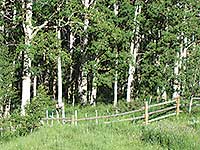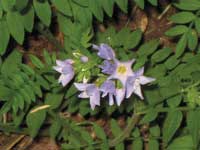HIKING HAPPENINGS August 2014
Gold Knob, at 11,055 feet, is one of the lowest and easiest peaks in the La Sal Mountains to climb, but with a gain of 1600 feet; it is still a hike not to be taken lightly. With the double whammy of high elevation and a steady steep grade, I am having serious thoughts about how much further I really want to go! On this clear summer day in late June, thunderstorms are not in the forecast. Consequently there is no good excuse for turning back - - so I just keep on trucking along. If all goes well, hopefully I will make it to the top!  This vigorous day started with a hop out of bed at 5:30. After a quick breakfast I’m rushing out the door and cruising along to the high country. The La Sals, the second highest range in Utah after the Uintas, was formed 25 to 28 million years ago when intrusive molten magma cooled into igneous rock. Over time successive intrusions pushed the overlying sediments up as much as 6,000 feet forming the mountains that we see today! This vigorous day started with a hop out of bed at 5:30. After a quick breakfast I’m rushing out the door and cruising along to the high country. The La Sals, the second highest range in Utah after the Uintas, was formed 25 to 28 million years ago when intrusive molten magma cooled into igneous rock. Over time successive intrusions pushed the overlying sediments up as much as 6,000 feet forming the mountains that we see today!My arrival at an early hour gives me the luxury of an unhurried day. Here at 9400 feet, Warner Lake, a high alpine mecca dominated by Haystack Mountain, and a popular hangout for fishermen, campers and picnickers, is an ideal place to pass the time.  According to excerpts from the histories of George A. Day and Eli Day, published in volume 41 of the Canyon Legacy, this location was originally called “The Upper Place.” Herbert Day, his wife Mary and their twelve children lived here in the summer because the grazing was good for their dairy cows. In the winter they lived in the “Lower Place,” currently known as Wilson Mesa. They marketed their dairy products at Miners Basin, Gold Basin and to the stockmen who worked in the mountains. Herbert Day and the older boys built the dam and ditch for their irrigation system on Wilson Mesa, but Warner Lake was named after a forest service ranger. The homestead was abandoned in 1912, and today nothing remains except the lake, dam and ditch, which is still used to transport water from Mill Creek to the reservoir. According to excerpts from the histories of George A. Day and Eli Day, published in volume 41 of the Canyon Legacy, this location was originally called “The Upper Place.” Herbert Day, his wife Mary and their twelve children lived here in the summer because the grazing was good for their dairy cows. In the winter they lived in the “Lower Place,” currently known as Wilson Mesa. They marketed their dairy products at Miners Basin, Gold Basin and to the stockmen who worked in the mountains. Herbert Day and the older boys built the dam and ditch for their irrigation system on Wilson Mesa, but Warner Lake was named after a forest service ranger. The homestead was abandoned in 1912, and today nothing remains except the lake, dam and ditch, which is still used to transport water from Mill Creek to the reservoir. In the spring of 1933, the Civilian Conservation Corps established a camp at the Warner Ranger Station near the current campground. In one season almost 200 men completed range improvements, overhauled trails and roads and dug lengthy water diversion ditches. They developed the reservoirs at Warner, Oowah, Clark and Medicine Lakes. The Geyser Pass Road and the Castleton-Wilson Mesa Road, now part of the La Sal Loop Road, were also rebuilt. In the spring of 1933, the Civilian Conservation Corps established a camp at the Warner Ranger Station near the current campground. In one season almost 200 men completed range improvements, overhauled trails and roads and dug lengthy water diversion ditches. They developed the reservoirs at Warner, Oowah, Clark and Medicine Lakes. The Geyser Pass Road and the Castleton-Wilson Mesa Road, now part of the La Sal Loop Road, were also rebuilt. Warner Lake is the hub for a series of trails and I opt for the less traveled Miners Basin Trail - the best access to Gold Knob. A refreshing grove of aspens encompasses me as I start at the billboard and walk through the richness of lupines, blossoms of blue flanking me on both sides. After passing through two gates I quickly go right on to a dirt road, which I leave immediately, taking a sharp right at a sign with an arrow.  Before long I’m cranking up for the serious upgrade ahead as the thick branches of Engelmann spruce and firs umbrella me in the welcoming relief of rippled shade. In the alpine morning coolness the serenade goes on and on: mountain chickadees “dee-dee-deeing” their trademark calls - ruby-crowned kinglets boisterously voicing their song - red-breasted nuthatches “yank-yank-yanking” their tinny trumpeted routine – all of it mingling with the fluted chorus of the hermit thrush. Before long I’m cranking up for the serious upgrade ahead as the thick branches of Engelmann spruce and firs umbrella me in the welcoming relief of rippled shade. In the alpine morning coolness the serenade goes on and on: mountain chickadees “dee-dee-deeing” their trademark calls - ruby-crowned kinglets boisterously voicing their song - red-breasted nuthatches “yank-yank-yanking” their tinny trumpeted routine – all of it mingling with the fluted chorus of the hermit thrush.Along the banks of a gentle stream I pause to soak in the lovely bouquet of flowers: blue columbines, red columbines, Richardson geranium, blue flax, splashy yellow daisies, bluebells and the heavy clusters of Jacob’s ladder with leaves that do look like a ladder. Then passing by a jumble of loose rock called scree, I easily tiptoe across the only stream crossing, a moist paradise that has attracted a handful of tiny iridescent blue butterflies.  At an aspen-lined meadow, a sign appears – right for the Mountain View Trail, left for the Miners Basin Trail. I swing left to start a long series of switchbacks. At this point I’ve covered a fair distance, but I still have a long way to go! At an aspen-lined meadow, a sign appears – right for the Mountain View Trail, left for the Miners Basin Trail. I swing left to start a long series of switchbacks. At this point I’ve covered a fair distance, but I still have a long way to go! After the first switchback I pass by a fallen-down log cabin. A little further I find the diggings of a small unproductive mine – obviously the dreams of striking it rich quickly faded away. When the switchbacks are about to end a big sloping meadow and Gold Knob finally come into view. Now, at a pile of rocks, I go left to take a different trail. This works well for a while until this route starts heading down. That’s the signal for me to start heading cross country as I begin angling up to the tree-lined ridge. Eventually I pick up another path that takes me directly to the top. Almost there the elevation is starting to take its toll, but what a nice surprise to be walking through a swath of golden banner flowers, clear up to the top.  Finally – the climax – I really am standing on top of Gold Knob! Now reaping the rewards of a spectacular panoramic scene, I can see all the way to the Henry Mountains, the Bookcliffs and the Abajos. I can also easily pick out Castle Valley, Porcupine Rim, Moab and Behind The Rocks. Then turning my attention to the peaks in the La Sals I find I am gazing at the prominent presence of Tuk No., Tukuhnikivatz, Mellenthein, Haystack, Tomasaki, Manns, Pilot and Green. Finally – the climax – I really am standing on top of Gold Knob! Now reaping the rewards of a spectacular panoramic scene, I can see all the way to the Henry Mountains, the Bookcliffs and the Abajos. I can also easily pick out Castle Valley, Porcupine Rim, Moab and Behind The Rocks. Then turning my attention to the peaks in the La Sals I find I am gazing at the prominent presence of Tuk No., Tukuhnikivatz, Mellenthein, Haystack, Tomasaki, Manns, Pilot and Green. Settling in for a leisurely high-in-the-sky lunch break, I am so happy to be at this marvelous on-the-edge spot - thrilled to have obtained this bird’s eye view. It was definitely worth every minute of the hard workout climbing up – and what’s more, the difficult part is over – from now on it’s downhill all the way back! To get to Warner Lake from Moab go south on Highway 191 for approximately eight miles before turning left at the sign for the Ken’s Lake-La Sal Loop Road. Then go right on to Spanish Valley Drive, which quickly becomes the La Sal Loop Road. After that drive 14 miles and turn right at the sign for Warner Lake. The dirt road to the lake, suitable for any vehicle, is five miles long. |